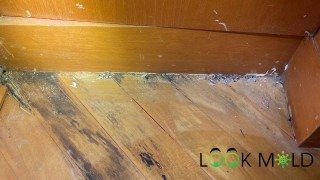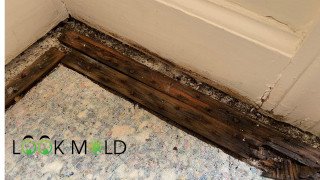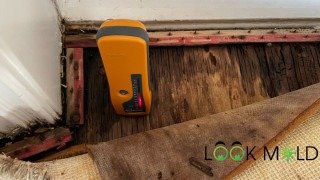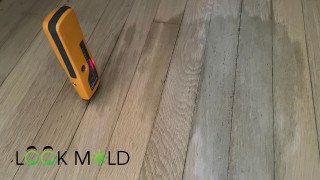Having mold on floors isn’t just an eyesore—it can pose serious health and structural risks. Whether it's hardwood, laminate, or carpet, mold can grow under almost any flooring type if moisture is present.
In this guide, you'll learn:
- ✅ What causes mold on floors
- ✅ Which flooring materials are most vulnerable
- ✅ How to remove mold safely
- ✅ When mold on the floor is dangerous
- ✅ How to prevent it from returning

🚱 Causes of Mold on Floors
Mold needs moisture to survive—and floors are a prime location due to foot traffic, spills, and hidden leaks.
Moisture often enters from plumbing leaks, window leaks, or cracks in your home’s envelope. Sometimes it seeps under baseboards or drywall, creating a hidden mold habitat. If you're concerned about nearby wall materials, check for mold behind baseboards and mold on drywall as well.
🔍 Common Causes of Floor Mold
| Cause | Description |
|---|---|
| Plumbing Leaks | Leaky pipes under floors or behind walls |
| Roof or Window Leaks | Water seeps down and settles at floor level |
| High Humidity | Trapped moisture in poorly ventilated areas |
| Slab or Foundation Cracks | Allows groundwater to creep into subflooring |
| Condensation | HVAC units, cold surfaces, or appliances |
🏛️ EPA states: "Mold will grow in places with a lot of moisture, such as around leaks in roofs, windows, or pipes."
— EPA: Mold and Moisture
🏠 Flooring Types and Mold Susceptibility
Not all flooring is created equal. Some materials trap moisture easily and provide the perfect conditions for mold.

Carpet, for instance, is a notorious culprit for harboring mold. If you’re dealing with musty smells or wet padding, read our full guide on removing mold from carpet.
| Flooring Type | Mold Susceptibility | Notes |
|---|---|---|
| Hardwood | High | Can absorb water; often grows Chaetomium |
| Laminate | Very High | Fiberboard core and plastic sheeting trap moisture |
| Engineered Wood | High | Plywood core supports microbial growth |
| Carpet & Padding | Very High | Traps dust and moisture; ideal for many mold types |
| Vinyl | Low | Moisture-resistant, but mold can grow underneath |
| Epoxy | Very Low | Non-porous, used mostly in garages |
| Concrete | Medium | Semi-porous; can hold moisture if unsealed |
| Tile | Low | Mold doesn’t grow on tile, but can grow under it |
| Marble | Low-Medium | Porous stone; supports mold in damp conditions |
| Subflooring (plywood) | High | Often affected if floor covering is compromised |

🧬 CDC says: “Mold can grow on virtually any organic substance if moisture and oxygen are present.”
— CDC: Basic Facts About Mold
📊 Mold Risk Matrix by Flooring Type
Wondering how at-risk your floors are? Use this quick reference table:
| Flooring Type | Mold Risk Level | Surface Mold | Mold Underneath | DIY Safe? | Notes |
|---|---|---|---|---|---|
| Carpet & Padding | 🔴 Very High | ✅ Yes | ✅ Yes | ⚠️ Maybe | Hard to dry, often smells musty |
| Laminate | 🔴 Very High | ✅ Yes | ✅ Yes | ⚠️ Maybe | Water traps under planks |
| Hardwood | 🟠 High | ✅ Yes | ✅ Yes | ⚠️ Maybe | Absorbs moisture quickly |
| Engineered Wood | 🟠 High | ✅ Yes | ✅ Yes | ⚠️ Maybe | Plywood core supports mold |
| Vinyl (LVP) | 🟡 Medium | 🚫 Rare | ✅ Yes | ✅ Yes | Water can seep below floating planks |
| Concrete | 🟡 Medium | ✅ Yes | N/A | ✅ Yes | Porous if unsealed |
| Tile | 🟢 Low | 🚫 Rare | ✅ Yes | ✅ Yes | Mold grows under if water gets to subfloor |
| Epoxy | 🟢 Very Low | 🚫 No | 🚫 No | ✅ Yes | Sealed and non-porous |
| Subfloor (Plywood) | 🔴 Very High | ✅ Yes | ✅ Yes | ❌ No | Usually requires pro removal |
⚠️ DIY Safe? = Safe only if mold is small, surface-level, and you’ve stopped the moisture source.
⚠️ Floating Floors: A Hidden Risk
Floating floor systems (common in vinyl and laminate) aren’t glued to the subfloor. Water can collect unnoticed beneath them. If your floor is buckling, lifting, or feels squishy—check for mold under it immediately.
🧽 How to Remove Mold from Floors
Removing floor mold isn’t just about scrubbing the surface. If water has seeped below, you'll likely need to remove and replace parts of the flooring.

This is especially important in areas like basements or crawl spaces, where ventilation is poor. For deeper guidance, see our articles on mold in basements and mold in crawl spaces.
🔎 EPA Recommendation: "If the moldy area is larger than 10 square feet, consult a professional."
DIY vs Professional Mold Removal
| Factor | DIY | Professional |
|---|---|---|
| Cost | Low | High |
| Speed | Slower | Faster |
| Area Size | Small (<10 sq ft) | Large, hidden, or widespread |
| Containment | Often skipped | Proper containment with negative pressure |
| Spore Spread Risk | Higher | Controlled |
| Tools Required | Basic household tools | Commercial-grade HEPA vacs, antimicrobials |
| Best For | Surface mold, early detection | Underfloor mold, black mold, structural issues |
✅ Surface Mold Cleaning (DIY-Safe)
- Mix detergent with warm water and scrub affected areas.
- For stubborn mold, use borax or undiluted vinegar.
- Avoid bleach on wood—it doesn't penetrate deeply and can damage finishes.

👷 When to Call a Mold Remediation Professional
Call a pro when:
- You’re dealing with structural wood rot
- Mold is under flooring and spreading
- It’s black mold or over 10 sq ft
🧰 FEMA notes: “If mold covers more than a few square feet, consider hiring a mold removal professional.”
— FEMA: Mold After a Disaster
⚕️ Is Mold on Floors Dangerous?
Yes, particularly if the mold produces mycotoxins.
Symptoms may include coughing, fatigue, asthma flares, and irritation. Learn more about symptoms in our guide to black mold dangers.

🛡️ How to Prevent Mold on Floors
To prevent future mold:
- Fix leaks fast
- Use dehumidifiers in problem areas
- Install exhaust fans in bathrooms and kitchens
For a full list, read 7 Expert Mold Prevention Tips.
❓ FAQs About Mold On Floors
How do I know if there's mold under my flooring?
Look for musty smells, soft spots, buckling, or discoloration. Floating floors that shift easily may also signal trapped moisture underneath.
Can I remove mold on floors myself?
Yes, if it’s surface-level and under 10 sq ft. Use detergent or vinegar, and follow containment precautions.
What if the mold is under laminate or vinyl flooring?
These materials often trap moisture. Removal of the floorboards may be necessary to inspect and remediate the mold properly.
Will insurance cover mold under flooring?
It depends. Some policies cover mold from sudden damage like burst pipes. Learn more about insurance coverage for mold here.
🧭 Final Thoughts from Brad Fishbein
As a Licensed Mold Assessor, I’ve seen just how easily a small leak under the floor can lead to a major mold issue. The key is knowing your materials, watching for warning signs, and acting quickly.
If you even suspect mold under your flooring—don’t ignore it.
Want personalized help? Leave a comment below.
Explore Related Topics:

Meet the author: Brad Fishbein is an ACAC council-certified Microbial Investigator. In the fall of 2012, he became a Licensed Mold Assessor in the State of Florida through the Department of Business & Professional Regulation. Brad has helped homeowners with over 5,000 successfully completed Mold Inspections since 2009.

